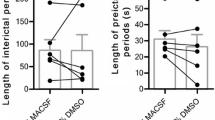Summary
By using electroencephalographic (EEG) and electromyographic recordings in anaesthetized and free-moving rats, two opioid peptides, known as selective agonists forμ andδ opiate receptors, respectively, were examined for their epileptogenic properties.
Theδ receptor peptide (DSTLE, 4.6–18.6 nmol, intraventricularly, ivt), a putativeδ opiate agonist, produced a dose-related increase of myoclonic contractions (MC) with epileptic discharges in anaesthetized rats and severe wet dog shakes, with occasionally falling down, in free-moving animals. Morphiceptin, a specificμ opiate agonist, used in equimolar doses and under the same experimental conditions, had a significantly less pronounced effect on the number of MC and epileptiform EEG phenomena. Similarly, DSTLE (18.6 nmol) injected in the CA2 area of the hippocampus, a region with a nearly equal distribution ofμ andδ opiate receptors, induced epileptic discharges in anaesthetized and free-moving rats, while an equimolar dose of morphiceptin had no significant effect.
It is suggested that the epileptiform activity of opioid peptides is mainly due to an activation ofδ opiate receptors in the central nervous system.
Similar content being viewed by others
References
Berkowitz, B. A., Ngai, S. H., Finck, A. O.: Nitrous oxide “analgesia”: resemblance to opiate action. Science194, 967–968 (1976).
Bieger, D., Larochelle, L., Hornykiewicz, O.: A model for the quantitative study of central dopaminergic and serotoninergic activity. Eur. J. Pharmacol.18, 128–136 (1963).
Chang, K.-J., Killian, A., Hazum, E., Cuatrecasas, P.: Morphiceptin (NH4-tyr-pro-phe-pro-CONH2): a potent and specific agonist for morphine (μ) receptors. Science212, 75–77 (1981).
Chang, K.-J., Cuatrecasas, P., Wei, E. T., Chang, J.-K.: Analgesic activity of intracerebroventricular administration of morphiceptin andβ casomorphins: correlation with the morphine (μ) receptor binding affinity. Life Sci.30, 1547–1551 (1982).
David, M., Moisand, C., Meunier, J.-C., Morgat, J.-L., Gacel, G., Roques, B. P.: (3H)tyr-D-ser-gly-phe-leu-thr: a specific probe for theδ-opiate receptor subtype in brain membranes. Eur. J. Pharmacol.78, 385–387 (1982).
Day, A. R., Freer, R. J., Liao, C. S.: Morphiceptin (β-casomorphin [1–4] amide): a peptide opioid antagonist in the field stimulated rat vas deferens. Res. Comm. Chem. Pathol. Pharmacol.34, 543–546 (1981).
Duka, T., Schubert, P., Wüster, M., Stoiber, R., Herz, A.: A selective distribution pattern of different opiate receptors in certain areas of rat brain as revealed byin vitro autoradiography. Neurosci. Lett.21, 119–124 (1981).
Dzoljic, M. R., v.d. Lely, A. J., v. Mourik, J. B. A.: Enkephalin-induced myoclonic twitches blocked by ergometrine and potentiated by haloperidol. Psychopharmacol.66, 111–116 (1979).
Dzoljic, M. R., v. d. Poel-Heisterkamp, A. L.: The role of the nucleus accumbens and nigrostriatum in enkephalin-induced myoclonus. Pharmacol. Biochem. Behav.13, 103–106 (1980).
Dzoljiz, M. R., v. d. Poel-Heisterkamp, A. L.: Delta opiate receptors are involved in the endopioid-induced myoclonic contractions. Brain Res. Bull.8, 1–6 (1982).
Dzoljic, M. R.: Opiate receptors and seizures: Proconvulsant action ofδ receptors and anticonvulsant action ofμ receptors. In: Advances in the Bioscience, Vol. 28: Current status of centrally acting peptides (Dhawan, B.N., ed.), pp. 107–113. Pergamon Press. 1982.
French, E. D., Siggins, G. R.: An iontophoretic survey of opioid peptide actions in the rat limbic system: in search of opiate epileptogenic mechanisms. Regulatory Peptides1, 127–146 (1980).
Frenk, H., Urca, G., Liebeskind, J. C.: Epileptogenic properties of leucine- and methionine-enkephalin: comparison with morphine and reversibility by naloxone. Brain Res.147, 327–337 (1978).
Gacel, G., Fournie-Zaluski, M.-C., Roques, B. P.: D-tyr-ser-gly-phe-leu-thr, a highly preferential ligand forδ opiate receptors. FEBS Lett.118, 245–247 (1980).
Gähwiler, B. H., Maurer, R.: Involvement ofμ receptors in the opioid-induced generation of bursting discharges in hippocampal pyramidal cells. Regulator Peptides2, 91–96 (1981).
De Groot, J.: The rat brain in stereotaxic coordinates, 4th ed. Verh. K. Ned. Akad. Wet.52, 11–40 (1972).
Haffmans, J., Blankwater, Y.J., Ukponmwan, O. E., Zijlstra, F.J., Vincent, J. E., Hespe, W., Dzoljic, M.R.: Correlation between the distribution of3H-labelled enkephalin in rat brain and the anatomical regions involved in the enkephalin-induced seizures. Neuropharmacol. (in press).
Henriksen, S. J., Bloom, F. E., McCoy, F., Ling, N., Guillemin, R.:β-Endorphin induces nonclusive limbic seizures. Proc. Natl. Acad. Sci. U.S.A.75, 5221–5225 (1978).
Hökfelt, T., Elde, R., Johansson, O., Terenius, L., Stein, L.: The distribution of enkephalin-immunoreactive cell bodies in the rat central nervous system. Neurosci. Lett.5, 25–31 (1977).
Illes, P.: An unexpected effect of opiates in the limbic system. TIPS3, 313–314 (1982).
Linseman, M. A.: Effects of morphine on cortex, hippocampus, and medial thalamus: a comparison between urethane-anaesthetized and paralyzed-awake rats. Brain Res. Bull.5, 121–125 (1980).
Lord, J. A. H., Waterfield, A. A., Hughes, J., Kosterlitz, H. W.: Endogenous opioid peptides: multiple agonists and receptors. Nature267, 495–499 (1977).
Martin, W. R.: Multiple opioid receptors. Life Sci.28, 1547–1554 (1981).
Meibach, R. C., Maayani, S.: Localization of naloxone sensitive (3H) dihydromorphine binding sites within the hippocampus of the rat. Eur. J. Pharmacol.68, 175–179 (1980).
Rossier, J., Bloom, F.: Distribution of opioid peptides. In: The endorphins (Malick, J. B., Bell, R. M. S., eds.). New York: Marcel Dekker. 1980.
Urca, G., Frenk, H., Liebeskind, J. C., Taylor, A. N.: Morphine and enkephalin: analgesic and epileptic properties. Science197, 83–86 (1977).
Urca, G., Liebeskind, J. C.: Electrophysiological indices of opiate action in awake and anaesthetized rats. Brain Res.161, 162–166 (1979).
Wheeler, H.: Effect of opiate receptor agonists on striatally-mediated head turning: anin vivo model of opiate delta receptor activation? Neuropharmacol.21, 941–944 (1982).
Zhang, A.-Z., Chang, J.-K., Pasternak, G. W.: The actions of naloxone on the binding and analgesic properties of morphiceptin (NH2tyr-pro-phe-pro-CONH2), a selective mu-receptor ligand. Life Sci.28, 2829–2836 (1981).
Zieglgänsberger, W., French, E. D., Siggins, G. R., Bloom, F. E.: Opioid peptides may excite hippocampal pyramidal neurons by inhibiting adjacent inhibitory interneurons. Science205, 415–417 (1979).
Author information
Authors and Affiliations
Rights and permissions
About this article
Cite this article
Haffmans, J., Dzoljic, M.R. Differential epileptogenic potentials of selectiveμ andδ opiate receptor agonists. J. Neural Transmission 57, 1–11 (1983). https://doi.org/10.1007/BF01250043
Received:
Issue Date:
DOI: https://doi.org/10.1007/BF01250043




